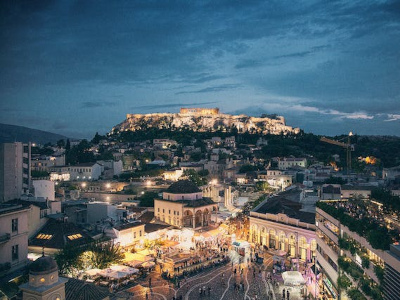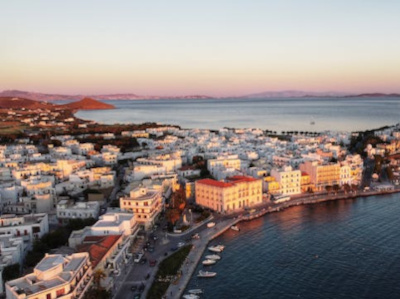Art is a form of self-expression, and many stories are told through art. Greece is known as the place where all the arts originate, including painting. Extraordinary pieces of art, mostly murals and pottery, are derived from ancient Greece, which shows the importance of art for the ancient Greeks and has been passed down to new generations. Additionally, some of the best painters originate from ancient Greece. The unique blend of heroism and beauty and the naturalistic portrayal of the human body stood out in these paintings. Unfortunately, many ancient Greek paintings have been lost over time. However, the legacy remains due to the talent of the painters and their discoveries of new painting techniques and methods. Among the many artists, here are five iconic Greek painters that you should know about:
Nikiforos Lytras
Born on the island of Tinos in 1832, Nikiforos Lytras remains a very important figure in the Greek art scene. He was interested in the arts from a young age and eventually studied at the Athens School of Fine Arts. He won a scholarship from King Otto in 1860 and continued studying at the Royal Academy of Arts in Munich. After he had finished his studies, he came back to Athens, where he taught pain in the Athens School of Fine Arts.
The realism move and the Royal Academy of Arts inspired Lytras’ work, where he paid attention to the precise repetition of everyday life. The Greek traditions are the main themes in his paintings. In particular, the Greek Independence War was one of his favorite themes to explore.
“Kalanta” is one of Lytra’s most famous paintings. This painting represents children with musical instruments going from home to home while singing traditional carols on Christmas Eve. Furthermore, other famous paintings include “Man playing his bouzouki”, “A grandma with her grandson” and “A girl eating an Easter egg”. All these paintings reflect the everyday life of Greek society during the 19th century.

https://www.pexels.com/photo/lighted-buildings-nighttime-951539/
Nikolaos Gyzis
Gyzis was born on the island of Tinos in 1882. He grew up with his parents and six siblings in Athens. He already started showing love and interest in the arts at a young age. He decided to study at the Athens School of Fine Arts. As well as Nikiforos Lytras, Gyzis continued his studies at the Royal Academy of Arts in Munich. Lytras was a good friend of Gyzis; he helped Gyzis establish and adjust to the German lifestyle. With honorary grades, Gyzis finished his studies and moved back to Athens, where he turned his family home into an atelier. After a short time, he was disappointed by the Greek conditions and returned to Munich in May 1874, where he continued living until his death in 1901.
The flow of academic realism and the conservative cultural movement of the school in Munich inspired Gyzis’ artwork. The majority of his artwork represents the Greek everyday life of the 19th century. Moreover, as a religious person, he dedicated many of his paintings to religion, such as “Idou o Nymfios erhetai” (“Behold, the Bridegroom Comes in the Midst of the Night”), which is one of the most important artworks made by Gyzis. Furthermore, he honored women in many of his paintings, which is unusual for a man of that time. Additionally, the Greek Independence War was an inspiration for Gyzis. In many of his paintings, he created scenes from the fight for Greek liberty against the Ottomans. The “Meta tin katastrophi ton Psaron” painting, which represents the fight of the people of Psara Island against their enemies, was one of his most famous paintings.

https://www.pexels.com/photo/aerial-view-of-tinos-greek-island-in-aegean-sea-13193123/
Nikos Eggonopoulos
Eggonopoulos, born in Athens in 1907, is one of the most important representatives of the surrealism movement in Greece. Until his 20s, he spent his time in Paris. In order to complete his military service, he came back to Greece. Eggonopoulos also studied at the Athens School of Fine Arts. He held his first showing and published his first poems after finishing his studies. However, he received loads of criticism from the art community. He served in the mountains of Albania against the Germans in 1941, and he became a prisoner of war. Fortunately, he escaped and came back to Greece on foot. After the war, he started his career as a professor at the National Technical University of Athens. Meanwhile, his paintings and poems were awarded many times, and he was recognized as one of the most important artists of contemporary Greece.
Eggonopoulos’ artworks represent an imaginary world. The inspiration is mainly derived from Greek mythology. Additionally, some of his work is inspired by Greek and Byzantine art.
Périclès Pantazis
Pantazis was born in 1849 in Athens, but his roots were in Epirus, Greece. He studied in Athens at the School of Fine Arts, where one of his professors was Nikiforos Lytras. He then continued his studies at the Royal Academy of Fine Arts in Munich, but the conservative German way of life did not suit him. So he chose Marseille, after Paris, as his base. There, he met famous impressionists, including Manet and Degas. He moved to Brussels in 1873, where he stayed until the end of his life in 1884. He created his art in this city and became one of the founders of the Belgian Impressionism Movement. In 1884, he passed away from tuberculosis at the age of 35.
Pantazis was the first Greek painter to go to the conservative school in Munich, where he integrated impressionism. He created many landscape paintings, mainly Belgian landscapes. His work also consists of portraits and dead nature. Pantazis’ works are characterized by a liberal expression of nature, mostly through the use of vivid colors and light. “Magkas pou troei karpouzi” (“Boy eating watermelon”) and “Aprilis” (“April”) are two of his most famous paintings.

https://pixabay.com/photos/munich-germany-city-cities-urban-391354/
Spyros Papaloukas
In 1892, in the village of Desfina near Delphi, Spyros Papaloukas was born. He showed interest and talent in the arts from an early age. He studied at the Athens School of Fine Arts at the age of eighteen. He continued his studies at the Grand Chaumière and the Académie Julian. He took part in many exhibitions after he had finished his studies and worked to develop his personal style. He visited Mount Athos in 1923 with the intention of studying its landscape and Byzantine art. This period defined his art form. In 1957, at the age of 65, he passed away in Athens. In honor of his life, the Greek state decided to rename the square in front of his atelier to Papaloukas Square.
Furthermore, Papaloukas’ artworks are mainly inspired by religion. Despite the fact that religion is not easily relatable to the impressionist movement, he succeeded in combining Byzantine spirituality and impressionism in a new way.
Sources:
https://www.ancienthistorylists.com/greek-history/17-ancient-greek-painters/
https://www.definitelygreece.com/greek-painters/
